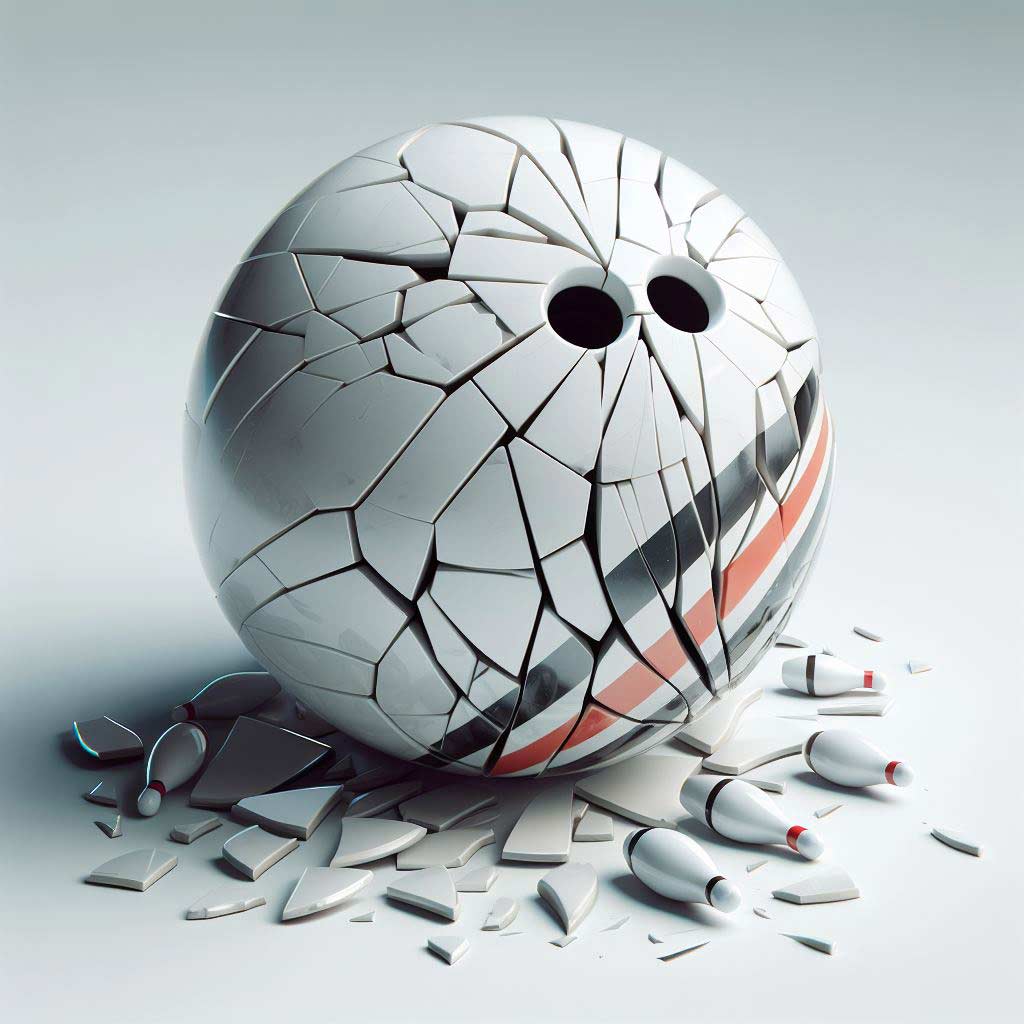As any seasoned bowler knows, a cracked bowling ball can be a frustrating and costly problem. A cracked ball not only affects your game performance, but it can also render the ball unusable, forcing you to invest in a replacement.
Understanding the common causes of bowling ball cracks and taking preventive measures is essential for maintaining the longevity and performance of your equipment.
In this comprehensive guide, we’ll delve into the primary reasons why bowling balls crack, explore effective strategies to avoid this issue, and discuss methods for repairing minor cracks. By the end, you’ll have a better grasp of how to keep your bowling balls in top condition and optimize your game for years to come.
Common Causes of Bowling Ball Cracks
Bowling balls are designed to withstand the rigors of the game, but they are not immune to cracking under certain conditions. Let’s examine the three primary reasons why bowling balls may crack:
1. Improper Drilling and Fitting
One of the leading causes of bowling ball cracks is improper drilling and fitting. When the holes for your fingers and thumb are not drilled correctly, it can create structural weaknesses in the ball that eventually lead to cracking.
Several drilling-related factors can contribute to this issue:
- Drilling holes too close to the edge of the ball: If the finger and thumb holes are drilled too close to the outer edge of the bowling ball, it can significantly weaken the ball’s structural integrity. The stress and pressure exerted on the ball during the release and swing can cause cracks to form along the edges of the drilled holes.
- Incorrect hole size or placement: Similarly, if the finger and thumb holes are not the appropriate size or are not positioned correctly, it can create stress points in the ball that are prone to cracking. Holes that are too large or too close together can particularly increase the risk of cracks developing.
- Drilling through the weight block or core: Some bowlers make the mistake of drilling their finger and thumb holes directly through the weight block or core of the bowling ball. This can severely compromise the ball’s structural stability and lead to cracks forming around the drilled areas.
To avoid these drilling-related issues, it’s crucial to work with an experienced pro shop that specializes in proper ball drilling and fitting. They will ensure that the holes are positioned and sized correctly to maintain the ball’s overall integrity.
2. Extreme Temperature Changes
Another common cause of bowling ball cracks is exposure to extreme temperature changes. Bowling balls are made from a combination of materials, including resin, polyester, and urethane, which can be sensitive to sudden temperature fluctuations.
- Sudden exposure to heat or cold: When a bowling ball is exposed to sudden and significant changes in temperature, it can cause the ball’s materials to contract or expand at different rates. This uneven expansion and contraction can lead to cracks forming on the ball’s surface. For example, leaving a bowling ball in a hot car on a summer day or bringing a ball straight from a cold storage unit to the bowling alley can both contribute to cracking.
- Improper storage conditions: Storing a bowling ball in an environment with extreme temperatures, such as a very hot or cold garage, shed, or basement, can also cause the ball to crack over time. The constant exposure to temperature variations puts stress on the ball’s materials, gradually weakening the structure and leading to cracks.
To mitigate the risk of temperature-related cracking, it’s essential to store your bowling balls in a temperature-controlled environment, such as your home or a climate-controlled storage facility. Avoid exposing the balls to sudden temperature changes, and always allow them to adjust slowly to new environments before use.
3. Excessive Oil Absorption
The third primary cause of bowling ball cracks is the accumulation of excess lane oil on the ball’s surface. Bowling lanes are treated with oil to maintain a consistent and smooth playing surface, but this oil can gradually seep into the ball’s materials over time.
- Bowling balls absorbing too much lane oil: As a bowling ball is used repeatedly on the lanes, it can gradually absorb more and more of the lane oil. This oil penetrates into the ball’s surface, causing the materials to swell and expand. Over time, this expansion can lead to the development of cracks on the ball’s surface.
- Lack of regular ball cleaning and maintenance: Failing to clean and maintain your bowling ball can exacerbate the issue of oil absorption. When a ball is not cleaned regularly, the accumulated oil can continue to seep deeper into the ball’s materials, increasing the risk of cracking.
To prevent excessive oil absorption and mitigate the risk of cracking, it’s essential to establish a regular ball cleaning and maintenance routine. This typically involves using a high-quality bowling ball cleaner and polishing the ball’s surface to remove any built-up oil and contaminants.
Preventive Measures to Avoid Bowling Ball Cracks
Now that we’ve explored the primary causes of bowling ball cracks, let’s dive into the preventive measures you can take to protect your equipment and extend its lifespan.
1. Proper Drilling and Fitting
As mentioned earlier, improper drilling and fitting is one of the leading causes of bowling ball cracks. To avoid this issue, it’s crucial to work with an experienced pro shop that specializes in ball drilling and fitting.
Work with an experienced pro shop: When having your bowling ball drilled, seek out a pro shop with a proven track record of providing accurate and precise drilling services. These professionals will have the expertise to ensure that the finger and thumb holes are positioned and sized correctly to maintain the ball’s structural integrity.
Avoid drilling through the weight block or core: One of the most common mistakes that can lead to cracking is drilling the holes directly through the weight block or core of the bowling ball. This can severely compromise the ball’s structural stability, so it’s crucial to avoid this practice.
Ensure proper hole placement and size: Work closely with the pro shop technician to ensure that the finger and thumb holes are positioned and sized appropriately for your hand and bowling style. Holes that are too close to the edge or are the wrong size can create stress points that are prone to cracking.
By working with a qualified pro shop and following their recommendations for proper drilling and fitting, you can significantly reduce the risk of cracks developing in your bowling ball.
2. Proper Ball Maintenance
Maintaining your bowling ball’s condition through regular cleaning and conditioning is another crucial step in preventing cracks.
Clean the ball regularly: Establish a routine for cleaning your bowling ball, using a high-quality bowling ball cleaner to remove any built-up oil, dirt, or contaminants from the surface. This will help prevent excessive oil absorption and the associated risks of cracking.
Condition the ball’s surface: In addition to cleaning, regularly conditioning the ball’s surface can help maintain its integrity and resilience. Using a bowling ball polish or conditioner can help replenish the ball’s protective outer layer and keep the materials from becoming too dry or brittle.
Store the ball in a temperature-controlled environment: As discussed earlier, sudden temperature changes can cause bowling balls to contract and expand, leading to cracks. Store your bowling balls in a temperature-controlled environment, such as your home or a climate-controlled storage facility, to minimize the risk of exposure to extreme temperatures.
By following a consistent ball maintenance routine and storing your equipment in the right conditions, you can significantly reduce the likelihood of cracks developing in your bowling balls.
3. Replacing Older or Damaged Balls
Even with proper drilling, fitting, and maintenance, bowling balls have a finite lifespan and will eventually need to be replaced. Identifying the signs of an aging or damaged ball can help you make informed decisions about when to retire a ball and invest in a new one.
Look for signs of cracking or structural damage: Regularly inspect your bowling balls for any visible signs of cracking, chipping, or other structural damage. These issues can worsen over time and eventually render the ball unusable.
Consider replacing the ball before it becomes unusable: Don’t wait until a ball is completely cracked or damaged before replacing it. If you notice minor cracks or other signs of wear, it’s generally better to retire the ball and invest in a new one before the damage becomes too severe.
Recognizing the limits of your bowling balls and being proactive about replacing them when necessary can help you avoid the frustration and performance issues that come with using a cracked or damaged ball.
Repairing Cracked Bowling Balls
In some cases, it may be possible to repair a bowling ball with minor cracks, rather than needing to replace it entirely. However, it’s important to understand the limitations and potential risks associated with these repair methods.
1. Repairing Minor Cracks
For small, superficial cracks on the ball’s surface, it may be possible to fill and seal the crack with a suitable epoxy or adhesive. This process typically involves the following steps:
- Thoroughly clean the cracked area to remove any dirt, oil, or contaminants.
- Apply a small amount of a high-quality epoxy or cyanoacrylate adhesive to the crack, ensuring it penetrates the entire length of the crack.
- Allow the adhesive to fully cure according to the manufacturer’s instructions.
- Carefully sand the repaired area to blend it back into the ball’s surface.
- Polish the repaired area to restore the ball’s finish and appearance.
It’s important to note that this type of minor crack repair may only be a temporary solution, as the underlying structural weakness in the ball remains. The repaired area may be more prone to future cracking, and the ball’s overall performance and longevity may be reduced.
2. Repairing Severe Cracks
For more severe or extensive cracks, the ball may need to undergo more extensive professional repair, or it may need to be replaced entirely. In these cases, it’s best to consult with a qualified pro shop or bowling ball repair specialist to assess the feasibility and safety of repairing the ball.
Some potential options for repairing severe cracks include:
- Filling and reinforcing the crack with specialized epoxy or resin compounds.
- Drilling and inserting pins or dowels to stabilize and strengthen the cracked area.
- Replacing the ball’s outer shell or cover stock to address more significant structural damage.
However, it’s important to note that for severely cracked balls, replacement may be the safer and more reliable option, as extensive repairs can compromise the ball’s overall integrity and performance.
Conclusion
Bowling ball cracks can be a frustrating and costly problem for bowlers of all levels. By understanding the common causes of cracking – including improper drilling and fitting, extreme temperature changes, and excessive oil absorption – you can take proactive steps to prevent this issue and extend the lifespan of your bowling equipment.
Partnering with an experienced pro shop, following a consistent ball maintenance routine, and being vigilant about replacing older or damaged balls are all crucial strategies for avoiding bowling ball cracks. And in the event that minor cracks do occur, knowing how to properly repair them can help you get back on the lanes with confidence.
By prioritizing the care and maintenance of your bowling balls, you can ensure that your equipment remains in top condition, allowing you to focus on honing your skills and enjoying the game you love. So, take the time to implement these preventive measures and keep your bowling balls performing at their best for years to come.





